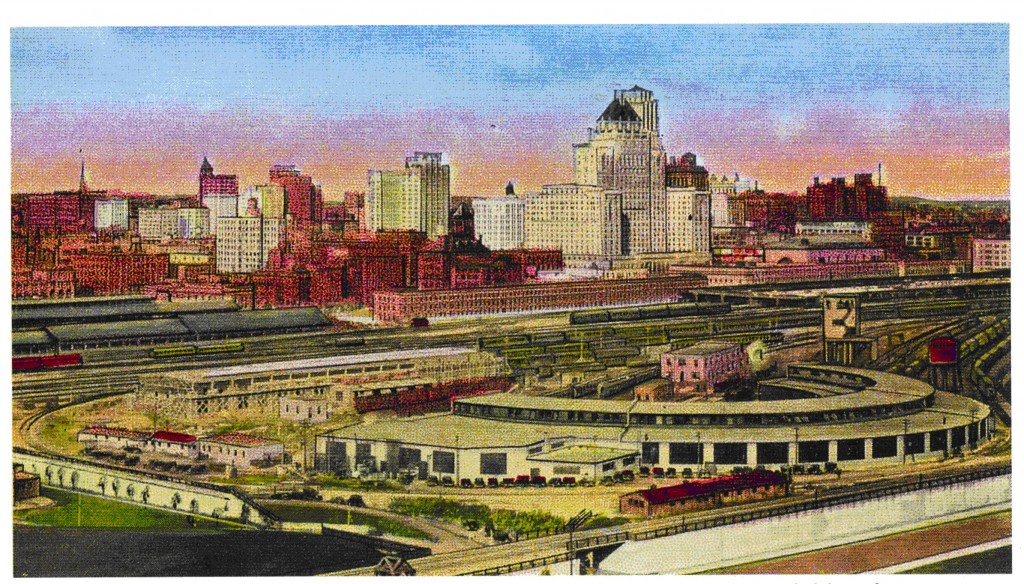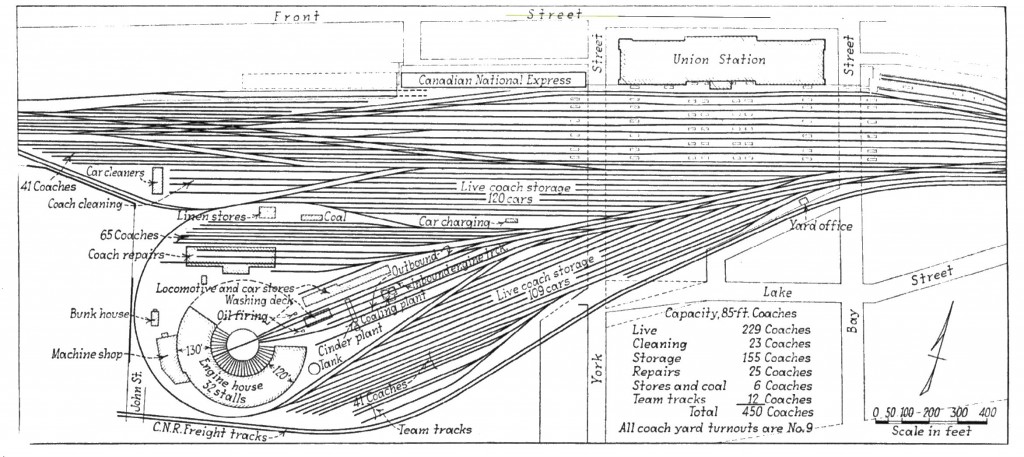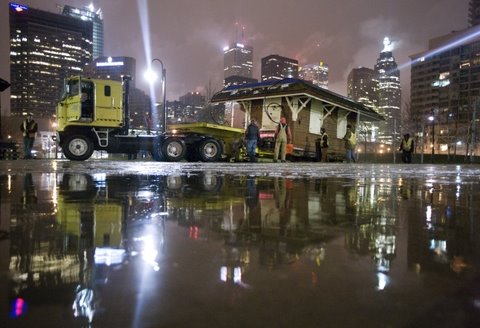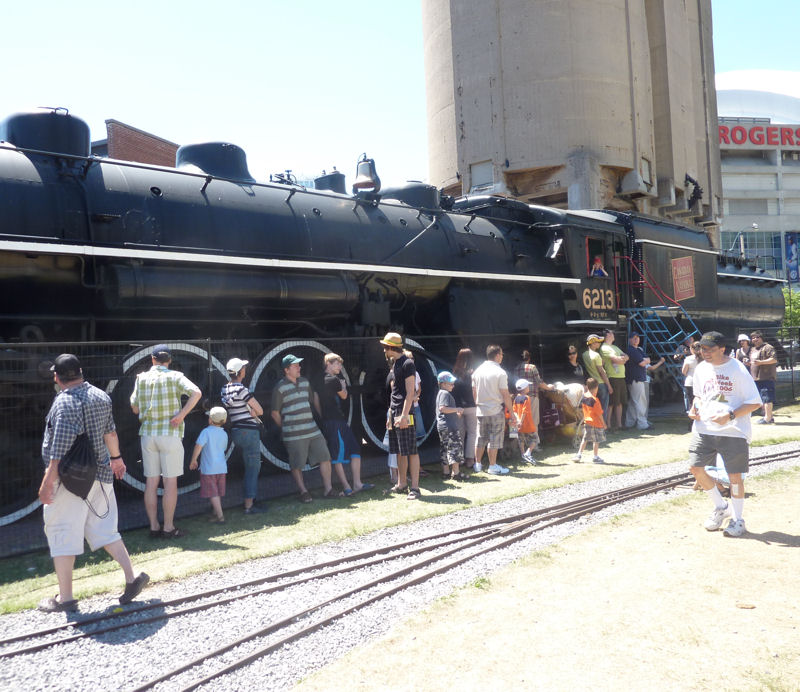The Toronto Railway Museum:
80 Years of History and 8 Years of Progress
By Derek Boles, TRM Chief Historian
Photographs by the author unless otherwise indicated
The Canadian Pacific Railway opened the John Street Roundhouse in two stages between 1929 and 1931 in order to service the locomotives and cars of the sixty CPR passenger trains a day that called at Toronto Union Station. The facilities contained 43 structures as well as the longest locomotive turntable and largest passenger car yard in Canada. During World War II, the facility was at its busiest and hundreds of employees worked at John Street around the clock. By the late 1960s, the number of intercity passenger trains had severely dwindled and both CP and Canadian National realized that their increasingly obsolete facilities occupied some of the most valuable downtown real estate in Canada. In 1968, the two railways announced the Metropolitan Centre development of 186 acres of land between Yonge Street and Bathurst Street. This would have required the demolition of both the Roundhouse and Union Station. Due to a softening real estate market and vociferous objections to the loss of the station, the Metro Centre was cancelled in the mid-1970s. By this time, there were only a handful of Canadian Pacific passenger trains remaining. Once VIA Rail took over responsibility for what remained of Canada’s intercity passenger rail network in 1978, the Toronto servicing facilities were shifted five miles west of Union Station. Thus began the transformation of the grimy industrial railway lands into a massive redevelopment of condominiums, office buildings and entertainment venues. These include the CN tower, Skydome (now Rogers Centre), Metro Hall, Roy Thomson Hall, the CBC Broadcast Centre, Ripley’s Aquarium, Maple Leaf Square, the Toronto Delta Hotel and the Air Canada Centre. CP moved out of the John Street Roundhouse in 1986 and, in return for regulatory concessions on the other local real estate developments, turned the property over to the city of Toronto for a railway museum. Inside the Roundhouse were stored three historic diesel locomotives, a streetcar, three freight cars, and two CPR passenger cars. There then followed a blizzard of reports with various recommendations about how the Roundhouse could be turned into an operating museum. One of these reports promoted dome over the entire Roundhouse, which would be transformed into a comprehensive transportation museum with a price tag of $50 million in today’s money. Unfortunately, the groups advocating for these schemes were not unable to establish a productive working relationship with city officials, nor were they able to obtain the necessary financing. Over the next decade, several miles of track were removed from John Street and all the structures were demolished except for the Roundhouse, the coaling tower and the water tower. In 1990, the Roundhouse was declared a National Historic Site, as it is “an architecturally and historically important surviving reminder of steam technology and the role of rail transportation in the city of Toronto.”
In the 1990s, the Metro Toronto Convention Centre was expanded south of the Union Station rail corridor into a massive new underground facility beneath what would become Roundhouse Park and the eastern segment of the rapidly deteriorating Roundhouse itself, requiring the dismantling of stalls 1-11. A giant excavation was carried out that extended from the turntable pit all the way over to Simcoe Street. This also required moving the 75-foot high concrete coaling tower 600 feet west of its original location to the west end of the Roundhouse. The Roundhouse was then stabilized with a commercial micro-brewery moving into the rebuilt stalls in 2000 while stalls 12-32 remained unoccupied for the next decade. The all-volunteer Toronto Railway Historical Association was created in 2001 and became advocates for a rail museum while establishing a productive relationship with the city. The City’s position was that the rail museum was only possible if most of the Roundhouse was leased out to commercial tenants. The rental income would provide the $10 million necessary to readapt the Roundhouse and develop Roundhouse Park into a showcase for the museum collection and a venue for its activities, while still remaining publicly accessible parkland. At this time, it also became apparent that a railway museum could only occupy three stalls of the Roundhouse, but with an understanding that it could expand into the machine shop on the west side of the structure.
The museum project would include the restoration of the original 120-foot turntable to operating condition; rebuilding most of the 32 standard gauge radial tracks surrounding the turntable, as well as other tracks throughout the park; moving the 1942 Canadian National No. 6213 (4-8-4) steam locomotive from the Exhibition grounds to Roundhouse Park; and the building of a new concrete “mini-depot” for the servicing and maintenance of the miniature railway. The project also included the creation of a historic railway village at the east end of the park by moving the 1896 Don Station from Todmorden Mills and the complete restoration of this building along with three other wooden railway structures, including the 1896 Grand Trunk interlocking tower Cabin D previously located west of Bathurst Street. While all this was going on, TRHA volunteers would build a ½-kilometre long narrow gauge right-of-way for an operating miniature railway and construct several passenger cars and a 7.5-inch gauge steam locomotive so museum visitors could ride through the park and vicariously appreciate a long-lost experience of Toronto’s railway heritage. The museum also acquired a working standard gauge 1950 industrial switching locomotive necessary to move other locomotives and rail cars around the park. The Roundhouse development began in 2007 and the Toronto Railway Museum opened in the spring of 2010, with Toronto Mayor David Miller the guest of honour at a gala celebration. A small indoor temporary museum displaying various historic artifacts was set up in stall 17. This included a computer driven simulation of the Toronto rail lands in the 1950s that was created by a team of ten museum volunteers and can be experienced by visitors inside a recreated diesel locomotive cab. While the three stalls occupied by the museum remained relatively intact from when the CPR moved out, the west end of the Roundhouse comprising stalls 18-32 was readapted into a retail furniture store. While many heritage advocates initially objected to this plan, the renovation was carried out with great sensitivity to the heritage fabric of the building and received the 2011 Heritage Toronto Award of Excellence for Architectural Conservation and Craftsmanship.
Despite the impressive progress made in the last 10 years, the Toronto Railway Museum has faced four formidable challenges:
- Three stalls are insufficient for a proper railway museum as most of the space is taken up by restoration workshops and there is little room for displays.
- Although the city of Toronto owns the Roundhouse and park, it provides no operating funds for the museum, which is completely self-supporting and depends on the revenue provided by museum admission fees and rides on the Roundhouse Park Miniature Railway.
- The museum is disconnected from the active rail system, requiring locomotives and cars to be brought in on a road vehicle float.
- Most disappointing, the 12,526 square foot machine shop was turned over to Toronto Hydro for the construction of a new electrical transformer station and is thus unavailable for museum purposes, despite earlier promises to the contrary.
Notwithstanding these significant limitations, the Toronto Railway Museum has been an outstanding success. In five years, 135,000 people have paid to visit the museum and almost a hundred volunteers have engaged in various restoration and interpretation projects. These have included, but are not limited to:
- The complete restoration of the previously decrepit 1913 Toronto, Hamilton & Buffalo caboose, which is seasonally open to visitors and is one of the most popular exhibits at the museum.
- The acquisition of several additional pieces of rolling stock, including the 1896 Pullman Car “Nova Scotia”, the VIA Rail LRC locomotive No. 6917, a crane, a flat car, and an additional caboose that will be used for revenue generating activities.
- Twelve permanent interpretive plaques located throughout the park so that visitors can guide themselves on a historic tour of the John Street facilities at the height of their operations.
- The restoration to operation of the 1944 Alco-built CPR S-2 switching locomotive No. 7020, the first CPR diesel to operate in the Toronto area.
- The acquisition of many additional historical artifacts, including several from Union Station, now in the process of an $800 million renovation.
- The installation of several interpretive displays inside the Roundhouse and in the four structures that make up the historic railway village.
In 2012, the Toronto Railway Museum hired a full-time manager and other staff has been employed on restoration projects requiring talents beyond those of our volunteer base. 2014 saw a significant increase in the number of visitors to the museum with the opening of the Ripley’s Aquarium of Canada across the street, the first major new tourist attraction in the city in several years. Few railway museums can boast of a location like Toronto’s, in the heart of the downtown entertainment district in Canada’s largest city, three blocks west of Union Station. Current projects include the restoration of the 1929 Canadian Pacific solarium-observation car “Cape Race” and the repainting of the CN 6213 steam locomotive, considered the crown jewel of the museum collection. Plans are now underway to raise funds for a new permanent building that will house all the facilities required by a world-class railway museum.
As published in the February 2015 issue of Branchline Magazine of the Bytown Railway Society and with their permission and that of the author, Derek Boles, TRHA Historian







